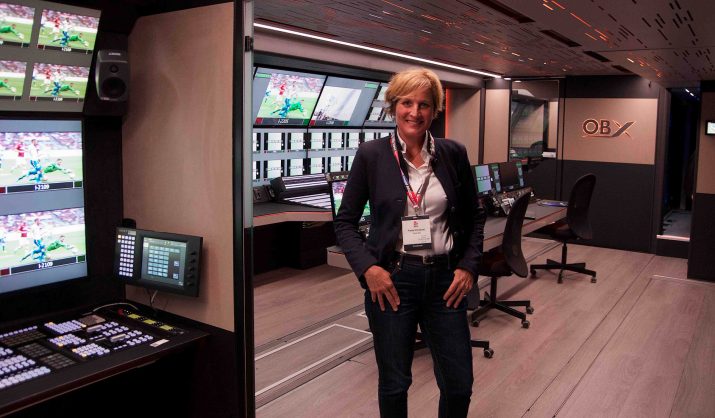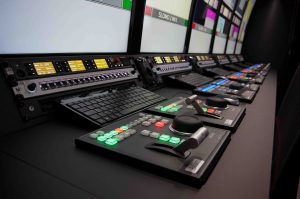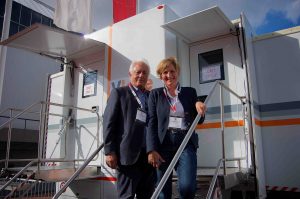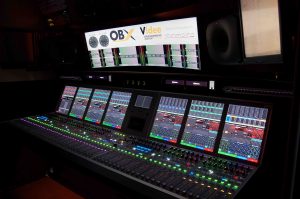Videe’s OBX aims to redefine the art of the OB vehicle

Wide open spaces to go with wide colour spaces: Paola Montanari in the main production area
In an era when many production teams prefer the home comforts of remote production, how does an OB truck attract customers? For the independent Italian facilities company Videe, the answer is “a particularly excellent working experience,” said its CEO and co-founder, Paola Montanari.
In building its new triple-expanding sided trailer, OBX, which was introduced at IBC, “we paid much attention to the working experience so people can work in a relaxing space,” she added.
It is certainly very spacious inside, and can be configured as one very large gallery (up to 75sq metres) or two separate, but connecting, production spaces. The secondary gallery has its own dedicated access, so can serve different customers.
The air conditioning changes the air every 30 minutes, using special carbon filters and ion treatment to make it as comfortable as possible, even if there are 36 people working in it.

OBX’s replay area uses Sony’s PWS-4500 server extended by the servers in the two camera BPUs
Users can also change the colour temperature of the indirect RGB LED lighting in each area – important as the truck is designed for wide dynamic range and has a Sony-based workflow offering a cinematic look, which “we’d like to define as the best in Europe at the moment,” she said.
OBX can be equipped with up to 30 cameras, and comes with two high-speed (8x 4K or 16x HD) Sony HDC-4800 S35 sensor cameras, which can be fitted with cinema-style lenses, ideal for particular sports or entertainment productions (or directors) that want that look.
It also has 18x HDC-4300 cameras with permanent 4K licenses, 2x HDC-3500 wireless cameras, with Vislink HCam transmitters) and 2x HDC-P50 PoV cameras. All the cameras support HDR.
“This cinematic look and wide colour spaces we think are good for the larger market of entertainment and cultural events, not just live sports,” she said.
Underlining the difference
Videe is one of the few independent OB companies in Italy, and also has offices (including post production) in Spain. It was set up in 1988, and has been involved with most types of programming, including making Survivor for both Italian and Spanish broadcasters, X Factor and other entertainment. In sport it has worked on a wide range of productions, from the Olympics to Champions League to doing Formula 1 as a remote production for the Spanish market.
“We needed to underline the difference between us and other companies,” she said. After spending a lot of time talking to customers to find out what they wanted, they decided to take a leap forward and design for future needs.
“We wanted to offer something special. We aimed to offer the best operational environment – many other trucks are very standardised,” she stated.
“When working on a major host broadcast project, our crews can be inside the truck for 14 hours or more – it is really important to us that they feel comfortable, they feel they have space, so that they deliver the best possible production,” added Videe’s chief engineer, Ilario Urbanetto.
OBX was built in five months, and “it was not just a question of the best technology, but also the best conditions,” said Montanari. This includes making it easy for users to customise equipment placement.
The switcher panel can be moved quickly to either side of the desk, as the director

Videe’s co-founders Bruno Mercuri (president) and Paola Montanari with OBX at IBC
prefers, equipment panels can be pulled forward for easier access, and accent lighting can be coloured to fit channel branding (useful where programmes cut away to shots inside the truck). “They can set up the environment as artistic people want,” she said.
“We put together our knowledge of the field with the choice of the best suppliers we trust,” such as Sony, Chromaline (the Italian systems integrator, which designed and engineered OBX), Canon for lenses, Calrec for audio and Imagine Communications for glue and router.
While many new OBs are IP-based, OBX uses SDI. “We think that our market is not ready for IP,” she explained. However, it is cabled for IP, and has a router that is currently used for control but can also support ST2110 IP, so transitioning to IP will not be difficult, and equipment (such as cameras, switcher and servers) has been bought with that in mind.
“We think that OBX is the right thing for now, the best we can offer to the market. We are very flexible.”
4800 reasons why
Unlike a majority of OB trucks, OBX does not have EVS replay. Instead, it has become one of the first OBs fitted with Sony’s PWS-4500 replay server. As the 4800 cameras also have servers in their BPU, and the 4500 can share capabilities with them, using Sony’s Shareplay technology, the whole set up effectively has eight servers, giving 64 replay channels.
The Shareplay system allows it offer an efficient, high-speed workflow, that can cope with multiple codecs with XAVC (both 4K and HD), Apple ProRes and Avid DNxHD recording capabilities, as well as high frame rates. It also handles both SDR and HDR, including HLG and S-Log3 in wide gamut.
It has 4x Sony HDRC-4000 4K HDR production converter units that can convert the intermediate production format to any desired distribution format, using its AIR (Artistic Intent Rendering) function.
The integration between the high-frame rate cameras and the server system was the main reason Videe became the first facility in Italy to adopt the 4800. It also helped that Sony was cost competitive, she added.
She had been getting feedback from customers “that even on sport the image needs to be spectacular,” which is why the cameras were so attractive, and it helped that no other OB company had them. “Because we offer directors the choice they would not have otherwise.”
She feels it also has the capabilities to appeal to the likes of Netflix and Amazon if they want Italian sport or live events. OBX is Dolby Atmos certified, which she claims is another first in Italy.
The triple-expanding truck, with coachwork by Tomassini Style, has a Sony XVS-8000 (160 in/64 out, 5M/E, 2DME, 4K switcher – with a 2M/E version in the secondary area), capable of delivering simultaneous UHD and HD output, and Sony up/down/cross converters.
There is an Imagine Platinum IP3 28RU router, with 512×1024 video I/O and 8000×8000 audio I/O. The video signals can be HD or Ultra HD, in either quad link or 2SI formats. The Platinum IP3 also hosts audio and video signal processing, and drives the 14 multiviewer displays in the production area. It uses Imagine’s Selenio MCP modular products for signal processing, including Dolby E encoding and management, and Selenio 6800+ modular processing units.
“To create the comfortable working space that Videe wanted, we had to have a complete rethink of traditional outside broadcast design, from the layout to the cabling to the floor – everything,” said Chromaline’s CEO, Nicola Dall’Asta.
He said they chose Imagine for image processing, routing and glue, because “Platinum IP3 is the only solution on the market that can deliver the number of wideband signals Videe required. Having processing and multiviewers inside the router saves a lot in the cost and time of cabling, and it saves space which we can give to the people.”
The monitor walls use Sony BVM-HX310 HDR reference monitors and PVM-A250 main monitors, alongside Samsung and LG LCD screens.

The 64-fader Calrec Artemis in OBX’s main audio area
The audio areas include Calrec Artemis 64-fader and Brio36 36-fader audio consoles (both integrated via the Hydra2 protocol), with Genelec monitoring. For intercom OBX has Riedel Artist-1024 matrix and IP smart panels, with Riedel Bolero talkback, and AEQ ISDN. The control system is HI – Human Interface from Broadcast Solutions, with a Cisco network system.
Dall’Asta, said: “In developing OBX, we started from scratch, and our goal was to think OB vans anew. The new HI control system mirrors this approach perfectly; it puts the user first. Therefore, it was a natural decision to deploy it in OBX.”
HI is used to control OBX’s audio/video signal routing, multiviewers and tally. It uses intuitive touch controls, similar to a smartphone, and newly-developed hardware control panels. It is IP-native, and integrates easily with the Imagine Communications router, embedders and multiviewers, which are under Imagine’s Magellan SDN Orchestrator control.
It uses auto-discovery and zero-config technologies to reduce the setup and configuration time. It also uses self-healing algorithms to remain running – even if parts of the system are distributed across different hardware platforms, or in separate locations.
